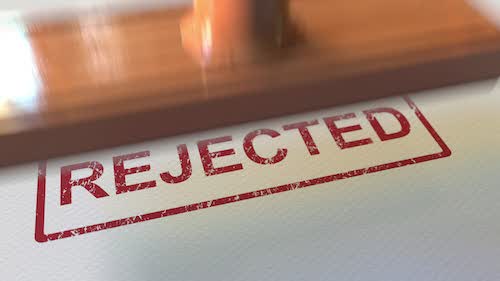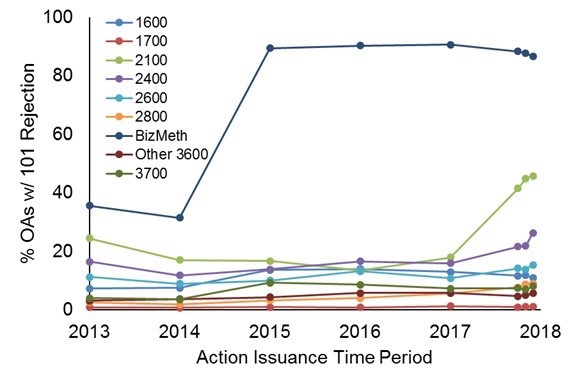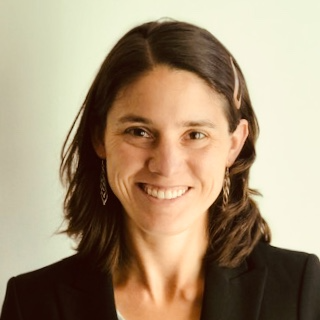 The frequency of any particular rejection type may be influenced by seminal Federal Circuit and Supreme Court cases. Judicial decisions are interpreted into policy decisions by the United States Patent Office (USPTO) and distributed to patent examiners in the form of examination guidance memoranda and other training materials. At least initially, major changes in jurisprudence are more likely to burden applications in the technological art analyzed by the court than applications in other arts as the USPTO will extend the courts analysis to those applications pending in that technological art. Yet, as the dust settles, the full impact of these decisions may be seen across all technology centers (TCs) of the USPTO.
The frequency of any particular rejection type may be influenced by seminal Federal Circuit and Supreme Court cases. Judicial decisions are interpreted into policy decisions by the United States Patent Office (USPTO) and distributed to patent examiners in the form of examination guidance memoranda and other training materials. At least initially, major changes in jurisprudence are more likely to burden applications in the technological art analyzed by the court than applications in other arts as the USPTO will extend the courts analysis to those applications pending in that technological art. Yet, as the dust settles, the full impact of these decisions may be seen across all technology centers (TCs) of the USPTO.
A great example of a decision that materially affected the frequency of a particular rejection type was the 2014 Alice v. CLS Bank decision.[1] The Court in Alice reasoned that abstract ideas merely embodied on a generic computer are not eligible for patent protection.[2] Almost immediately after Alice, the USPTO began issuing new subject-matter eligibility rejections under the abstract-idea exception to the statutory categories of patent eligibility. The ubiquity of subject-matter eligibility rejections in office actions exploded, leading many to wonder whether software implemented inventions remained patentable at all.
This effect was largely centered in business method art units of TC 3600. For example, the number of allowances issued from business-method art units dropped from 24% in the months before Alice was decided to about 3% in months after.[3] Though more recent analysis identified an uptick in allowances in the business-method art units, the probability of receiving an allowance remained about four to five times lower when compared to the probabilities in other technology areas.[4] Many of the court decisions holding claims to be ineligible were from patents having been issued from these art units, so it is not particularly surprising that the USPTO focused immediate post-Alice training in these art units.
Examiners have not been the only obstacle to securing patents for business-method technologies. For example, we recently analyzed Patent Trial and Appeal Board (PTAB) ex parte appeal decisions having had Appeal Briefs filed after the Alice decision. We reviewed PTAB decisions from computer related technology centers, including TCs 2100, 2400, 2600 and the business method portion of TC 3600. Nearly all eligibility rejections at issue stemmed from the business-method art units[5], and a mere 7% of those appeals were successful (i.e. reversed).[6] Thus, the Alice decision had a significant impact on the applications from business method art units.
Eligibility Rejections are Appearing with Greater Frequency in Non-Business Method Technology Centers
Our previous studies of regular prosecution and appeals suggested that Alice was rather inconsequential to patenting prospects for other computer-related technology areas. However, recent anecdotal accounts from practitioners suggest that eligibility rejections are becoming more common in the other TCs. Further, it appears as though the USPTO has increased training on Alice and eligibility assessments in the other TCs.
Thus, we collected new data to determine whether eligibility rejections have statistically increased in TC 2100, 2400 and 2600: Using LexisNexis® PatentAdvisorSM, we analyzed all office actions issued by the USPTO during each of the following time periods:
- October 1, 2017-December 31, 2017;
- January 1-14, 2017;
- January 1-14, 2016;
- January 1-14, 2015;
- January 1-14, 2014; and
- January 1-14, 2013.
Specifically, for each office action, we tracked (using LexisNexis® PatentAdvisorSM data) the associated art unit and which types of rejections were issued. We separated the office actions by TC (further separating TC 3600 into the business-method art units (“BizMeth”) or other art units (“Other 3600”)) and by date of issuance.
Notably, the prevalence of the eligibility rejections in TCs 2100, 2400, and 2600 still remains small compared to that in the business-method art units. Consistent with our previous results[7], our present analysis shows that there was a nearly immediate post-Alice jump in the percentage of office actions from business method art units that included a subject-matter eligibility rejection. In the six months after Alice was decided, the percentage of office actions including an eligibility rejection from business method art units increased by 258%. Any increase in the percentage of eligibility rejections observed for other TCs was negligible. Further consistent with our previous results[8], since 2015, the percentage of office actions with eligibility rejections from business-method art units has seen a small year-over-year decline. Thus, the timing characteristics trends relating to the business-method art units differ substantially relative to the other TCs. Nearly immediately since Alice, the prevalence of eligibility rejections in the business-method art units substantially increased and has shown modest changes since, while the prevalence of eligibility rejections in other computer-related TCs remained rather constant across the Alice-decision timer period, though recent shifts are substantial.
This data shows that the prevalence of eligibility rejections in non-business-method computer-related TCs (e.g., 2100, 2400, and 2600) has increased after Alice, though this increased prevalence is only associated with recent time periods. Across the first two weeks of 2014 (prior to the Alice decision), 12.3% of the office actions issued across TCs 2100, 2400 and 2600 included an eligibility rejection. Three years later, and about 2 ½ years after the Alice decision, the percentage notched higher to 14.6% by the beginning of 2017. But by October of 2017, the prevalence jumped to 25.0% (and was 29.3% by December of 2017). Thus, the prevalence of eligibility rejections doubled across 2017, while it had remained substantially constant for years after Alice.
Conclusions
Four years after the Alice decision, we seem to just now be detecting the full impact of the decision. The initial response by the USPTO resulted in an somewhat expected increase in the percentage of applications with eligibility rejections from business-method art units. Three years after Alice, eligibility rejections became much more common across the remaining computer-related technology centers (i.e. 2100, 2400, and 2600). However, while the percentage of applications with eligibility rejections from the computer-related technology centers is much higher now than three years ago, the percentage is unlikely to increase to the percentage of applications with eligibility rejections from the business-method art units.
The sudden increase in eligibility rejections from other computer-related technology centers may have a number of causes. For example, case law from the Federal Circuit and the USTPO began to expanded the application of Alice to inventions that appear abstract despite not being directed to a traditional business-method concept. In the first few months after Alice, the USPTO trained examiners to identify abstract ideas based on a claim being similar to claims the courts had already found to be abstract. Initially, the PTAB and Federal Circuit decisions analyzed few, if any, non-business-method patents under the Alice framework. Thus, having few, if any, cases for comparison, non-business-method art units found few applications abstract. The recent increase may be due to the PTAB and Federal Circuit analyzing more applications and patents in the technological arts examined in TCs 2100, 2400, and 2600.[9]
Another possible cause for the increase in eligibility rejections may be the uneven training given to examiners. As the subject matter of Alice, as well the cases decided shortly thereafter by the PTAB and Federal Circuit, frequently corresponded to the subject matter examined by the business-method art units, the USPTO likely focused the initial eligibility training effort on business-method examiners. As the number of post-Alice PTAB and Federal Circuit eligibility expanded, so did the USPTO’s training efforts which used the extra case law to provide better guidance to examiners outside the business-method art units. Therefore, the recent surge in eligibility rejections from TCS 2100, 2400, and 2600 may be caused by the USPTO’s increased training efforts in these areas.
The increase in the percentage of office actions with eligibility rejections in TC 2100 was much higher than the increase in other computer related technology centers TC 2400 and TC 2600. Given that TC 2100 is a primarily software-focused technology center, this trend discrepancy suggests that post-Alice eligibility assessments performed by software examiners present increased challenges for patenting software based inventions.[10] In business-method art units, we have seen many applicants turn to appeal to address eligibility rejections that cannot be resolved with the examiner.[11] It remains to be seen whether the increase in eligibility rejections from the computer-related technology centers will trigger a similar increase in appeals in these technology centers. Thus, we may not yet be seeing the full effect of Alice on the patent prosecution landscape: it will be telling to track the prosecutions of applications that are now rejected under § 101 in TC 2100 (e.g., to determine an extent to which they are likely to become abandoned, to resort to an appeal, to receive additional office actions before an allowance, etc.). In the meantime, in the words of the USPTO Director Andrei Iancu: “it is unclear what is patentable and what is not, and that can depress innovation”.[12]
_______________
[1] See Alice Corp. Pty. Ltd. v. CLS Bank Int’l, 573 U.S. _, 134 S. Ct. 2347 (2014).
[2] See Bilski v. Kappos, 561 U. S. 593, 614 (2010).
[3] Kate Gaudry, “Post-Alice, Allowances are a Rare Sighting in Business-Method Art Units”, IPWatchDog, 2014, https://ipwatchdog.com/2014/12/16/post-alice-allowances-rare-in-business-method/id=52675/
[4] Kate Gaudry, “Is there a Tide-Change in the Prospects of Patenting Business Method Innovations?”, IPWatchDog, 2017, https://ipwatchdog.com/2017/05/25/prospects-patenting-business-method-innovations/id=83693/
[5] Hayim et al., “Nearly All Biz-Method Appeals Contest Eligibility Rejection”, Law360, 2018, https://www.law360.com/articles/1017405; also available at https://www.kilpatricktownsend.com/-/media/Files/articles/2018/Nearly-All-Biz-Method-Appeals-Contest-Eligibility-Rejection.ashx
[6] Hayim et al., “Nearly All Post-Alice Eligibility Rejections are Affirmed in Whole by the PTAB”, Lexology, 2018, https://www.lexology.com/library/detail.aspx?g=b5dcb8ae-3478-4e4b-b344-38258b910431
See also Hayim et al., “Nearly All Post-Alice Eligibility Rejections are Affirmed in Whole by the PTAB”, JDSupra, 2018, https://www.jdsupra.com/legalnews/nearly-all-post-alice-eligibility-74926/
[7] Kate Gaudry, “Post-Alice, Allowances are a Rare Sighting in Business-Method Art Units”, IPWatchDog, 2014, < https://ipwatchdog.com/2014/12/16/post-alice-allowances-rare-in-business-method/id=52675/
[8] Kate Gaudry, “Is there a Tide-Change in the Prospects of Patenting Business Method Innovations?”, IPWatchDog, 2017, https://ipwatchdog.com/2017/05/25/prospects-patenting-business-method-innovations/id=83693/
[9] See Core Wireless Licensing v. LG Electronics, (Fed. Cir. 2018); See also Bascom Global Internet Services, Inc. v. AT&T Mobility LLC, AT&T Corp., 827 F.3d 1341 (Fed. Cir. 2016) (both Core Wireless and Bascom included a subject matter eligibility decision based on patents classified in technologies examined by TC 2100.)
[10] We note that the data does not indicate whether the examiners are likely to maintain the rejections throughout prosecution
[11] Hayim et al., “PTAB is Bogged Down by Eligibility Appeals”, IPWatchDog, 2018, https://ipwatchdog.com/2018/03/05/ptab-bogged-eligibility-appeals/id=94337/
[12] Gene Quinn, “Iancu: ‘It is unclear what is patentable and what is not, and that can depress innovation’”, IPWatchDog, 2018, https://ipwatchdog.com/2018/05/22/iancu-unclear-patentable-depress-innovation/id=97559/

![[IPWatchdog Logo]](https://ipwatchdog.com/wp-content/themes/IPWatchdog%20-%202023/assets/images/temp/logo-small@2x.png)



![[Advertisement]](https://ipwatchdog.com/wp-content/uploads/2024/04/Patent-Litigation-Masters-2024-sidebar-700x500-1.jpg)

![[Advertisement]](https://ipwatchdog.com/wp-content/uploads/2021/12/WEBINAR-336-x-280-px.png)
![[Advertisement]](https://ipwatchdog.com/wp-content/uploads/2021/12/2021-Patent-Practice-on-Demand-recorded-Feb-2021-336-x-280.jpg)
![[Advertisement]](https://ipwatchdog.com/wp-content/uploads/2021/12/Ad-4-The-Invent-Patent-System™.png)






Join the Discussion
13 comments so far.
Mark Nowotarski
May 27, 2018 01:34 pmCurious @12 “it says a lot about arbitrary and capricious nature of patent examination.”
Well put. I dug a little deeper into art units 2123 & 2128. I looked at 20 recent rejections in each art unit. 95% of them had an Alice 101 rejection. So the question then becomes, what do you have to do to overcome a 101 rejection in the particular art unit and with the particular examiner you have been assigned to.
Curious
May 26, 2018 07:52 pmSo it really boils down to who is your examiner.
Oh so true and it says a lot about arbitrary and capricious nature of patent examination.
Anon
May 25, 2018 06:57 pm“So it really boils down to who is your examiner.”
Another indicator of “Void for Vagueness”….
Mark Nowotarski
May 25, 2018 04:20 pmJonn @4,
“I would be interested to see an overlay of that chart showing the allowance rate of 2123 & 2128 Simulations and Modeling.”
I checked into the data on Patent Advisor, and it looks like Art unit 2123 is fine in terms of allowing cases at its normal pre Alice levels.
Art unit 2128, on the other hand, is having real issues. Some examiners are allowing at pre Alice levels. Many others however have pretty much stopped allowing as of the beginning of 2017. So it really boils down to who is your examiner.
If you would like to discuss in detail, drop me a note at [email protected] or contact me through my new web site http://www.survivingalice.com
Anon
May 25, 2018 10:00 amNight Writer @ 8,
I had come across a fascinating article about the physics of information, but my computer crashed, and I was not able to find the link again.
If I recall correctly, the article was discussing some work from way back from 1948 that tied the real world physical effects of information to its place in reality (and not as some ethereal, magic incantation).
I am also reminded (generally) of the view (from several different science fiction shows) that “magic” is really nothing more than science beyond the level of comprehension of those believing in magic.
Night Writer
May 25, 2018 08:06 am@2 momo
That is well said and what I have experienced too. I had a 101 rejection and the examiner said I could find art for this, but I am not going to bother. He even laughed at me.
A couple friends at the PTO told me that what Lee was doing was perfecting 101 rejections in 3600 and then planned on moving them to all art units with the same types of numbers in 3600.
But, you know, the reality is that 101 makes as much sense for hardware circuits as it does for business methods. The same arguments can be used. Every invention comes down to old stuff plus some theory of what you doing that is actually implemented with the old stuff. They just say the theory of what you are doing is abstract and the old stuff doesn’t add anything. Those arguments can work on any claim.
Anon
May 25, 2018 07:26 amLost in Norway @ 3,
Hardware being “abstract” (and leaving that term undefined – a separate point, but worth mentioning) is NOT new. Heck, even some of the claims in the Alice decision itself were stipulate by both sides to have passed the statutory category portion of 101; that is, both sides had agreed and it was not an issue before the Court that some of the claims wiped out as being “abstract” were hard goods (hardware).
This was raised in the immediate aftermath of the Alice decision.
This then is NOT one of those items somehow being “misapplied” by lower courts – this is something that directly flows from the Supreme Court itself.
Anon
May 25, 2018 07:19 amJust wait until the natural “extension” of the logic being used for the computing arts is applied to any art field in which components that are known (even ubiquitous) are used to craft the claim (the “as a whole” being eliminated).
Every claim (ever) for the statutory categories (nominally called the “hard goods” categories) will fail under that extension.
What is more ubiquitous than protons, neutrons and electrons?
All any hard goods invention is IS a statement of taking ubiquitous items and “applying” them according to the laws of nature into some configuration.
And this is not even that “extreme” of a step to take to show that the “logic” being used cannot be correct.
momo
May 24, 2018 05:43 pm@3 Lost In Norway:
Add to that they claim all the hardware parts are just “general computing devices” and may be dismissed for 101 analysis.
Jonn
May 24, 2018 04:13 pmI bet I can tell you exactly what caused that spike in two words: Electric Power. Decided 08/2016.
That decision has laid waste to some AUs. I would be interested to see an overlay of that chart showing the allowance rate of 2123 & 2128 Simulations and Modeling.
Lost In Norway
May 24, 2018 03:25 pm@2 momo
I must admit to a certain amount of shock that Alice would be applied to all-hardware circuits. What law of nature, natural phenomenon, or abstract idea does a piece of hardware capture?!
Talk about an examiner just meeting their quota.
momo
May 24, 2018 12:42 pmThe Examiners have learned that 101 rejections may be made in with no evidence or work, on their parts.
The rejections can be made in an arbitrary and capricious manner by copying and pasting a few form paragraphs. I have had Examiners fold on 102/103 rejections because “Why bother? you’ll never get past the 101 rejection.”
And when asked for guidance, the only response has been “Give more detail”.
These are for non-software, clearly all-hardware circuit and computer architecture claims.
If I had a magic lever at my job where I had to do no meaningful work and still met my quota, I’d start using it all the time too.
As for “training”, I am sure the grapevine in the PTO canteen has trained them well on this technique.
Anon
May 24, 2018 09:37 amOne might even say ubiquitous…
😉